Top ten drought-tolerant plants

Agapanthus 'Black Jack' adds structural interest to drought-tolerant garden planting schemes
©Branded Garden Products
If you want a low-maintenance garden that looks good in the heat, thrives on very little water and provides much-needed habitat for wildlife, then you’re in the right place. From scented perennials to lush grasses and brightly coloured sedums, here's our top ten list of plants for a drought-stricken garden:
- Lavender
- Eryngium 'Blue Hobbit'
- Cistus x pulverulentus 'Sunset'
- Verbena bonariensis 'Lollipop'
- Pennisetum alopecuroides
- Perovskia atriplicifolia 'Little Spire'
- Yucca filamentosa 'Bright Edge'
- Osteospermum
- Sedum 'Sunsparkler'
- Hibiscus 'Flower Tower Ruby'
Read on for more information about our featured specimens, or browse our full range of drought-tolerant plants for even more choice.
1. Lavender

Use lavender to edge pathways or as wildlife-friendly hedging
Image: Lavender 'Hidcote' from Thompson & Morgan
One of the most popular drought-tolerant plants, lavender thrives in hot, dry conditions. With silver/green foliage that grows readily in almost any soil type, this hardy shrub can withstand high temperatures with no ill effects. Its heavily-scented flowers come in a range of colours from elegant white to traditional purple. Varieties such as 'Hidcote' and 'Munstead' are amongst the best-known, and are sometimes planted as a low hedge. As an added bonus, these drought-tolerant plants are loved by bees and butterflies too!
2. Eryngium planum 'Blue Hobbit'

Sea holly flowers from July to early autumn
Image: Eryngium planum 'Blue Hobbit' from Thompson & Morgan
Eryngium, or Sea Holly, is a very useful perennial for its ability to cope with hot, dry conditions and coastal locations. Loved by pollinating insects, it makes a useful addition to a wildlife garden, or for filling gaps in cottage garden borders. Eryngium planum 'Blue Hobbit' produces dramatic cones of tiny blue flowers that are surrounded by a spiky, electric-blue collar. Being of a shorter stature too, 'Blue Hobbit' is perfect for patio containers where they will soak up the heat and produce magnificent sprays of up to 100 flowers!
3. Cistus x pulverulentus 'Sunset'
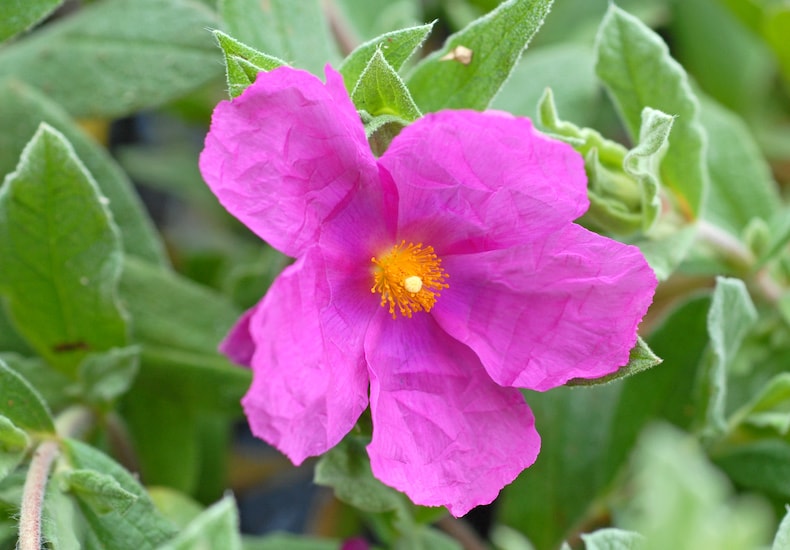
Rock roses thrive in poor, dry soils and can withstand temperatures as low as -5℃
Image: Cistus x pulverulentus 'Sunset' from Thompson & Morgan
From June to August the bright pink, tissue-paper blooms of the stunning Cistus x pulverulentus 'Sunset' are borne in abundance, each lasting just a day before a new flower opens to take its place. The evergreen grey-green wavy-edged foliage provides good year-round interest and makes the perfect backdrop for the vibrant flowers. Commonly known as the Rock Rose or Sun Rose, this low-growing shrub is a 'must-have' for hot, sunny borders and gravel gardens. Cistus 'Sunset' enjoys poor, dry soils where many plants would struggle, and copes well in coastal positions.
4. Verbena bonariensis 'Lollipop'
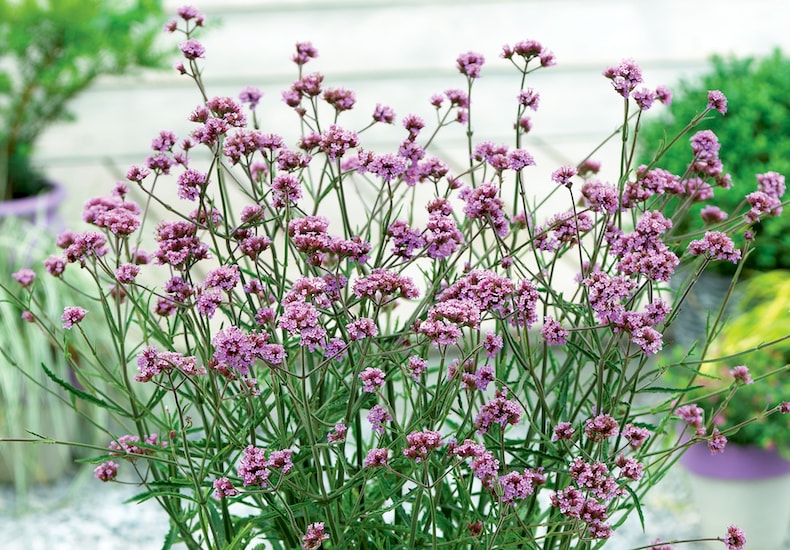
This dwarf Verbena is perfect for patio containers
Image: Cistus x pulverulentus 'Sunset' from Thompson & Morgan
Like its much taller cousins, Verbena bonariensis 'Lollipop' boasts the same tight clusters of floating purple flowers but has short, compact stems that reach only half the height. The thin leaves and strong, almost wiry stalks make it a great plant for dry and sunny borders as it loses very little moisture through them. A well-shaped, uniform plant with an open airy habit, this hardy dwarf verbena blooms from June to September. Perfectly proportioned for patio pots, it also looks great at the front of borders where it has a wonderful delicate effect.
5. Pennisetum alopecuroides

Fill gaps in your perennial or shrub borders with low maintenance Fountain grass
Image: Pennisetum alopecuroides from Thompson & Morgan
Pennisetum alopecuroides (commonly known as Fountain Grass) is a highly decorative ornamental plant that provides almost all year round interest in the garden. Low-maintenance and clump-forming, it’s ideal for filling gaps in perennial and shrub borders. The grassy foliage is neat, but stays quite inconspicuous until the flower heads appear during late summer. But, once they appear, they really dazzle, with spikelets that look like a fluffy squirrel's tail! Leave the decorative seedheads on your Fountain Grass plants into the autumn for extended interest.
6. Perovskia atriplicifolia 'Little Spire'
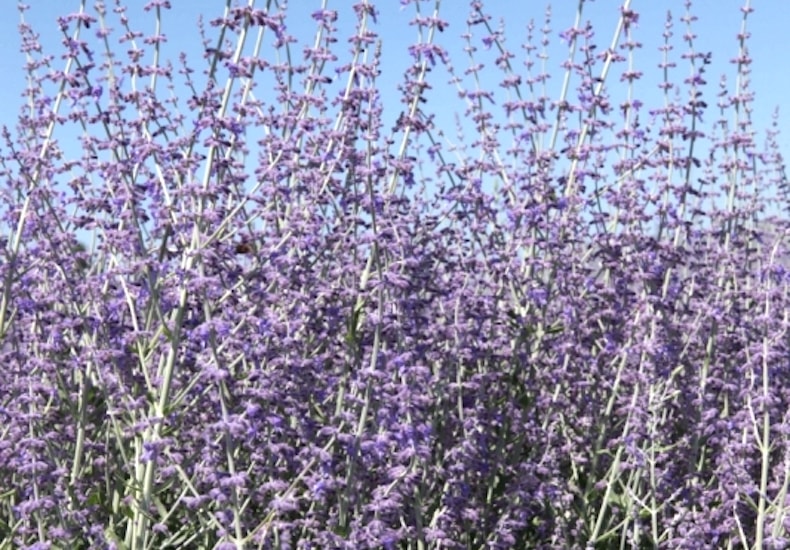
This compact Russian Sage plant keeps its shape and form well
Image: Perovskia atriplicifolia 'Little Spire' from Thompson & Morgan
Commonly known as Russian Sage, Perovskia atriplicifolia 'Little Spire' is a scented, low-maintenance perennial that establishes itself in the garden quickly and is ideal for beginners. The foliage is silvery and aromatic, and it looks fantastic when planted en masse. The blue flowers are loved by bees and butterflies and provide useful colour later in the summer. A smaller cousin of Perovskia atriplicifolia 'Blue Spire', the scaled down and compact ‘Little Spire’ grows to about 75cm tall, making it ideal for container-growing.
7. Yucca filamentosa 'Bright Edge'

The flower spikes on this Yucca can reach up to 2m high!
Image: Yucca filamentosa 'Bright Edge' from Thompson & Morgan
Grown for its majestic foliage and showy summer flowers, this hardy evergreen provides colour and structure in the garden. Yucca filamentosa 'Bright Edge' is aptly named, featuring architectural, sword-shaped, dark green leaves, each edged with a bright gold margin. From July to August, statuesque panicles of large, bell-shaped flowers rise above the foliage in a striking display. This cultivar makes a handsome shrub for sunny borders, with good drought-resistance once established. It’s equally useful as an evergreen container plant for a year-round focal point on your patio.
8. Osteospermum

Osteospermum 'Purple Sun' was shorlisted for the RHS Chelsea Plant Of The Year 2019
Image: Osteospermum 'Purple Sun' from Thompson & Morgan
Also called African daisies, hardy Osteospermums thrive in hot, dry, poor conditions, establishing themselves as some of the hardest-working flowers in the garden! Perfect for containers, rockeries and the front of sun-baked borders, you can expect long-lasting, vibrant summer colour and weed-suppressing ground cover from these easy-to-grow plants. A real stalwart of summer, if you want a colourful but low-maintenance garden, these are the flowers for you.
9. Sedum 'Sunsparkler'
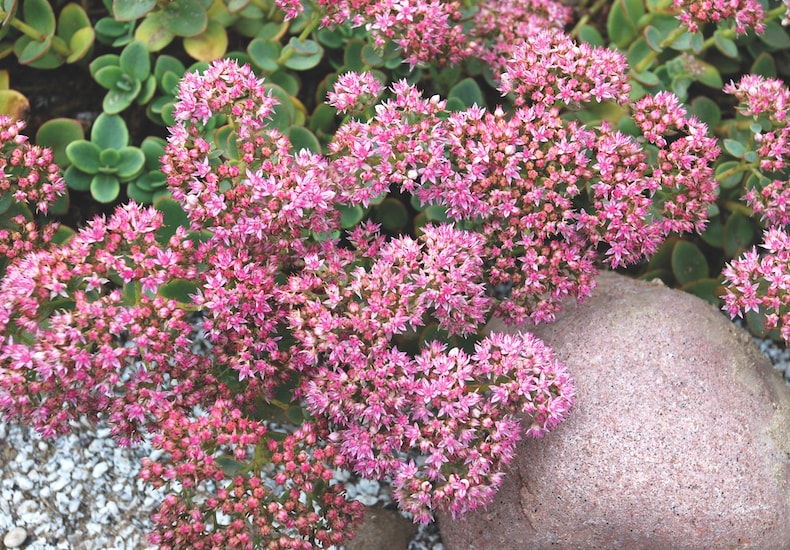
Smothered in pink flowers from late summer, this hard-working sedum is perfect for attracting pollinators
Image: Sedum 'Sunsparkler Lime Zinger' from Thompson & Morgan
Recently introduced from American breeding, Sedum 'Sunsparkler Lime Zinger' is part of a series of showy little Stonecrops that feature fabulous leaf colour, neat growth habit and large, showy flower heads. ‘Sunsparkler Lime Zinger’ features bright green leaves with claret red edges. In late summer, the plant is smothered with raspberry pink pollinator-friendly flowers. The low, spreading stems form perfect groundcover in alpine gardens and rockeries, or for softening the edges of paths.
10. Hibiscus 'Flower Tower Ruby'
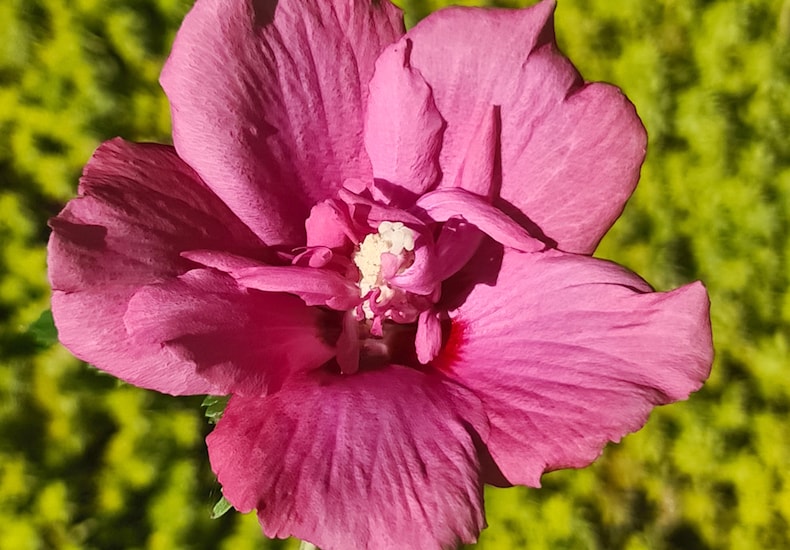
This gorgeous hibiscus creates a tower of blooms from late summer to autumn
Image: Hibiscus 'Flower Tower Ruby' from Thompson & Morgan
If you’re looking for height and structure, the tall columnar habit of Hibiscus 'Flower Tower Ruby' is perfect for narrow borders, or large containers. Reaching 3m tall, it can be kept to your desired height with regular pruning. Producing masses of dark pink semi-double flowers from July to October, Hibiscus 'Flower Tower Ruby' makes a spectacular and drought-tolerant focal point once established.
Return To
Popular Top 10 Articles
- Top 10 Winter Vegetables
- Top 10 Potato Varieties
- Top 10 Easy-to-grow Fruit
- Top 10 Winter Bedding Plants
- Top 10 Spring Flowering Bulbs
- Top 10 Summer Flowering Bulbs
- Top 10 Autumn/ Winter Flowering Bulbs
- Top 10 Evergreen Shrubs
- Top 10 Evergreen Shrubs for Small Gardens
- Top 10 Easy-to-grow Flowers
- Top 10 Cut Flowers
- Top 10 Hanging Basket Plants
- Top 10 Plants for Patios
- Top 10 Houseplants
- Top 10 Climbing Plants
- Top 10 Perennial Plants
- Top 10 Hardy Plants for Winter
- Top 10 Winter Garden Tips
- Top 10 Ornamental Grasses

Written by: Graham Ward
I've been gardening for as long as I can remember, my earliest memory being planting seeds in my Grandfather's prestige flower bed and having a prize lettuce growing there, which he proudly left to show everyone. Since then, gaining knowledge and experience from both my Grandfather and my Father, I've continued to garden, both as a hobby and later on as a professional gardener and landscaper for 12 years. I love all aspects of it, from the design and build, to the planting out of summer borders with plants you've either grown from seed or raised from plugs. Unusual varieties always catch my eye and I'm keen to try growing them, even if sometimes it means learning from my mistakes.Sign Up For Exclusive Special Offers




© 2025 Thompson & Morgan. All rights reserved. A division of Branded Garden Products Limited.
Sign up for exclusive offers!



